CrossFit Motivates a 41-Year-Old Obese Man to Change His Lifestyle and Achieve Long-Term Health Improvements: A Case Report
Abstract
1. Introduction
1.1. Changing Physical Activity Behaviour in the Workplace
1.2. Potential of CrossFit® as a Workplace Health Intervention
2. Materials and Methods
2.1. Participants
2.2. CrossFit Intervention
2.3. Data Collection
3. Results
3.1. Capability
“I feel stronger now. My endurance increased, and I can perform even complex movements like Muscle-Ups or Snatches now. I feel fitter while mountain biking and less fatigued after a tour.”
“In CF, it is always possible to scale the training to your fitness level. Even when I am injured, I can train and adjust the training according to my needs or ask a coach what I should do.”
3.2. Opportunity
“We received e-mails from the corporate health management on a regular basis during the past few years that promoted participation in some sort of physical activity. Furthermore, physical activity is fundamental at this university, as almost all students are active soldiers.”
“Right from the start, there was a nice atmosphere during training. The trainers actively responded to the participants and adapted the training individually.”
3.3. Motivation
“In CF, exercises and workout structure change constantly. It challenges you to learn new movements on a regular basis. After performing difficult movements for the first time, such as my first pullup or snatch, my motivation increased.”
3.4. Behavior
4. Discussion
4.1. Initial Behavioral Change
4.2. Behavioral Maintenance
4.3. Limitations
5. Conclusions
Supplementary Materials
Author Contributions
Funding
Institutional Review Board Statement
Informed Consent Statement
Data Availability Statement
Acknowledgments
Conflicts of Interest
References
- Guthold, R.; Stevens, G.A.; Riley, L.M.; Bull, F.C. Worldwide Trends in Insufficient Physical Activity from 2001 to 2016: A Pooled Analysis of 358 Population-Based Surveys with 1·9 Million Participants. Lancet Glob. Health 2018, 6, e1077–e1086. [Google Scholar] [CrossRef] [PubMed]
- Garber, C.E.; Blissmer, B.; Deschenes, M.R.; Franklin, B.A.; Lamonte, M.J.; Lee, I.-M.; Nieman, D.C.; Swain, D.P. Quantity and Quality of Exercise for Developing and Maintaining Cardiorespiratory, Musculoskeletal, and Neuromotor Fitness in Apparently Healthy Adults. Med. Sci. Sport. Exerc. 2011, 43, 1334–1359. [Google Scholar] [CrossRef] [PubMed]
- World Health Organization. Preventing Noncommunicable Diseases in the Workplace through Diet and Physical Activity; World Health Organization: Geneva, Switzerland, 2008. [Google Scholar]
- Burn, N.L.; Weston, M.; Atkinson, G.; Graham, M.; Weston, K.L. Brief Exercise at Work (BE@Work): A Mixed-Methods Pilot Trial of a Workplace High-Intensity Interval Training Intervention. Front. Sport. Act. Living 2021, 3, 179. [Google Scholar] [CrossRef] [PubMed]
- Eather, N.; Babic, M.; Riley, N.; Harris, N.; Jung, M.; Jeffs, M.; Barclay, B.; Lubans, D.R. Integrating High-intensity Interval Training into the Workplace: The Work-HIIT Pilot RCT. Scand. J. Med. Sci. Sport. 2020, 30, 2445–2455. [Google Scholar] [CrossRef]
- Burn, N.; Heather Norton, L.; Drummond, C.; Ian Norton, K. Changes in Physical Activity Behaviour and Health Risk Factors Following a Randomised Controlled Pilot Workplace Exercise Intervention. AIMS Public Health 2017, 4, 189–201. [Google Scholar] [CrossRef]
- To, Q.G.; Chen, T.T.L.; Magnussen, C.G.; To, K.G. Workplace Physical Activity Interventions: A Systematic Review. Am. J. Health Promot. 2013, 27, e113–e123. [Google Scholar] [CrossRef]
- Bredahl, T.V.G.; Christensen, R.S.; Justesen, J.B.; Christensen, J.R. Adherence to Physical Activity in a Workplace Setting—A Qualitative Interview Study. Cogent Med. 2019, 6, 1581446. [Google Scholar] [CrossRef]
- Marshall, A.L. Challenges and Opportunities for Promoting Physical Activity in the Workplace. J. Sci. Med. Sport 2004, 7, 60–66. [Google Scholar] [CrossRef]
- Michie, S.; van Stralen, M.M.; West, R. The Behaviour Change Wheel: A New Method for Characterising and Designing Behaviour Change Interventions. Implement. Sci. 2011, 6, 42. [Google Scholar] [CrossRef]
- Glassman, G. The CrossFit Level 1 Training Guide, 3rd ed.; CrossFit Incorporated: Washington, DC, USA, 2020. [Google Scholar]
- Claudino, J.G.; Gabbett, T.J.; Bourgeois, F.; de Souza, H.S.; Miranda, R.C.; Mezêncio, B.; Soncin, R.; Cardoso Filho, C.A.; Bottaro, M.; Hernandez, A.J.; et al. CrossFit Overview: Systematic Review and Meta-Analysis. Sport. Med. Open 2018, 4, 11. [Google Scholar] [CrossRef]
- Gianzina, E.A.; Kassotaki, O.A. The Benefits and Risks of the High-Intensity CrossFit Training. Sport Sci. Health 2019, 15, 21–33. [Google Scholar] [CrossRef]
- Meyer, J.; Morrison, J.; Zuniga, J. The Benefits and Risks of CrossFit: A Systematic Review. Workplace Health Saf. 2017, 65, 612–618. [Google Scholar] [CrossRef] [PubMed]
- Dominski, F.H.; Serafim, T.T.; Siqueira, T.C.; Andrade, A. Psychological Variables of CrossFit Participants: A Systematic Review. Sport Sci. Health 2021, 17, 21–41. [Google Scholar] [CrossRef] [PubMed]
- Drake, N.; Smeed, J.; Carper, M.; Crawford, D. Effects of Short-Term CrossFit Training: A Magnitude-Based Approach. J. Exerc. Physiol. Online 2017, 20, 111–133. [Google Scholar]
- Ekkekakis, P.; Hall, E.E.; Petruzzello, S.J. The Relationship between Exercise Intensity and Affective Responses Demystified: To Crack the 40-Year-Old Nut, Replace the 40-Year-Old Nutcracker! Ann. Behav. Med. 2008, 35, 136–149. [Google Scholar] [CrossRef]
- D’Alpino, I.A.; Moterosso, J.P.C.; Botaro, W.R.; da Silva, A.O.C.; Sant’Anna, P.G.; Junior, A.T.; Verardi, C.E.L.; de Souza Zanini, G. Comparison between Mood States, Stress and Recovery in CrossFit® Competitors and Non-Competitors. J. Phys. Educ. Sport 2022, 22, 2611–2617. [Google Scholar] [CrossRef]
- Heinrich, K.M.; Carlisle, T.; Kehler, A.; Cosgrove, S.J. Mapping Coaches’ Views of Participation in CrossFit to the Integrated Theory of Health Behavior Change and Sense of Community. Fam. Community Health 2017, 40, 24–27. [Google Scholar] [CrossRef]
- Bycura, D.; Feito, Y.; Prather, C. Motivational Factors in CrossFit® Training Participation. Health Behav. Policy Rev. 2017, 4, 539–550. [Google Scholar] [CrossRef]
- Sibley, B.A.; Bergman, S.M. What Keeps Athletes in the Gym? Goals, Psychological Needs, and Motivation of CrossFitTM Participants. Int. J. Sport Exerc. Psychol. 2018, 16, 555–574. [Google Scholar] [CrossRef]
- Brandt, T.; Heinz, E.; Klaaßen, Y.; Limbara, S.; Mörsdorf, M.; Schinköthe, T.; Schmidt, A. MedXFit—Effects of 6 Months CrossFit® in Sedentary and Inactive Employees: A Prospective, Controlled, Longitudinal, Intervention Study. Health Sci. Rep. 2022, 5, e749. [Google Scholar] [CrossRef]
- Fountaine, C.J.; Piacentini, M.; Liguori, G.A. Occupational Sitting and Physical Activity Among University Employees. Int. J. Exerc. Sci. 2014, 7, 295–301. [Google Scholar]
- Brown, T.C.; Volberding, J.; Baghurst, T.; Sellers, J. Faculty/Staff Perceptions of a Free Campus Fitness Facility. Int. J. Workplace Health Manag. 2014, 7, 156–170. [Google Scholar] [CrossRef]
- Knox, E.C.L.; Musson, H.; Adams, E.J. Workplace Policies and Practices Promoting Physical Activity across England. Int. J. Workplace Health Manag. 2017, 10, 391–403. [Google Scholar] [CrossRef] [PubMed]
- Baillot, A.; Chenail, S.; Barros Polita, N.; Simoneau, M.; Libourel, M.; Nazon, E.; Riesco, E.; Bond, D.S.; Romain, A.J. Physical Activity Motives, Barriers, and Preferences in People with Obesity: A Systematic Review. PLoS ONE 2021, 16, e0253114. [Google Scholar] [CrossRef] [PubMed]
- De Winter, L.; Gutman, L.M. Facilitators and Barriers to Fitness Bootcamp Participation Using the Behaviour Change Wheel. Health Educ. J. 2022, 81, 3–16. [Google Scholar] [CrossRef]
- Cook, G.; Burton, L.; Hoogenboom, B.J.; Voight, M. Functional Movement Screening: The Use of Fundamental Movements as an Assessment of Function—Part 1. Int. J. Sport. Phys. Ther. 2014, 9, 396–409. [Google Scholar]
- Cook, G.; Burton, L.; Hoogenboom, B.J.; Voight, M. Functional Movement Screening: The Use of Fundamental Movements as an Assessment of Function—Part 2. Int. J. Sport. Phys. Ther. 2014, 9, 549–563. [Google Scholar]
- Fisher, J.; Sales, A.; Carlson, L.; Steele, J. A Comparison of the Motivational Factors between CrossFit Participants and Other Resistance Exercise Modalities: A Pilot Study. J. Sport. Med. Phys. Fit. 2017, 57, 1227–1234. [Google Scholar] [CrossRef]
- Dominski, F.H.; Matias, T.S.; Serafim, T.T.; Feito, Y. Motivation to CrossFit Training: A Narrative Review. Sport Sci. Health 2020, 16, 195–206. [Google Scholar] [CrossRef]
- Kwasnicka, D.; Dombrowski, S.U.; White, M.; Sniehotta, F. Theoretical Explanations for Maintenance of Behaviour Change: A Systematic Review of Behaviour Theories. Health Psychol. Rev. 2016, 10, 277–296. [Google Scholar] [CrossRef]
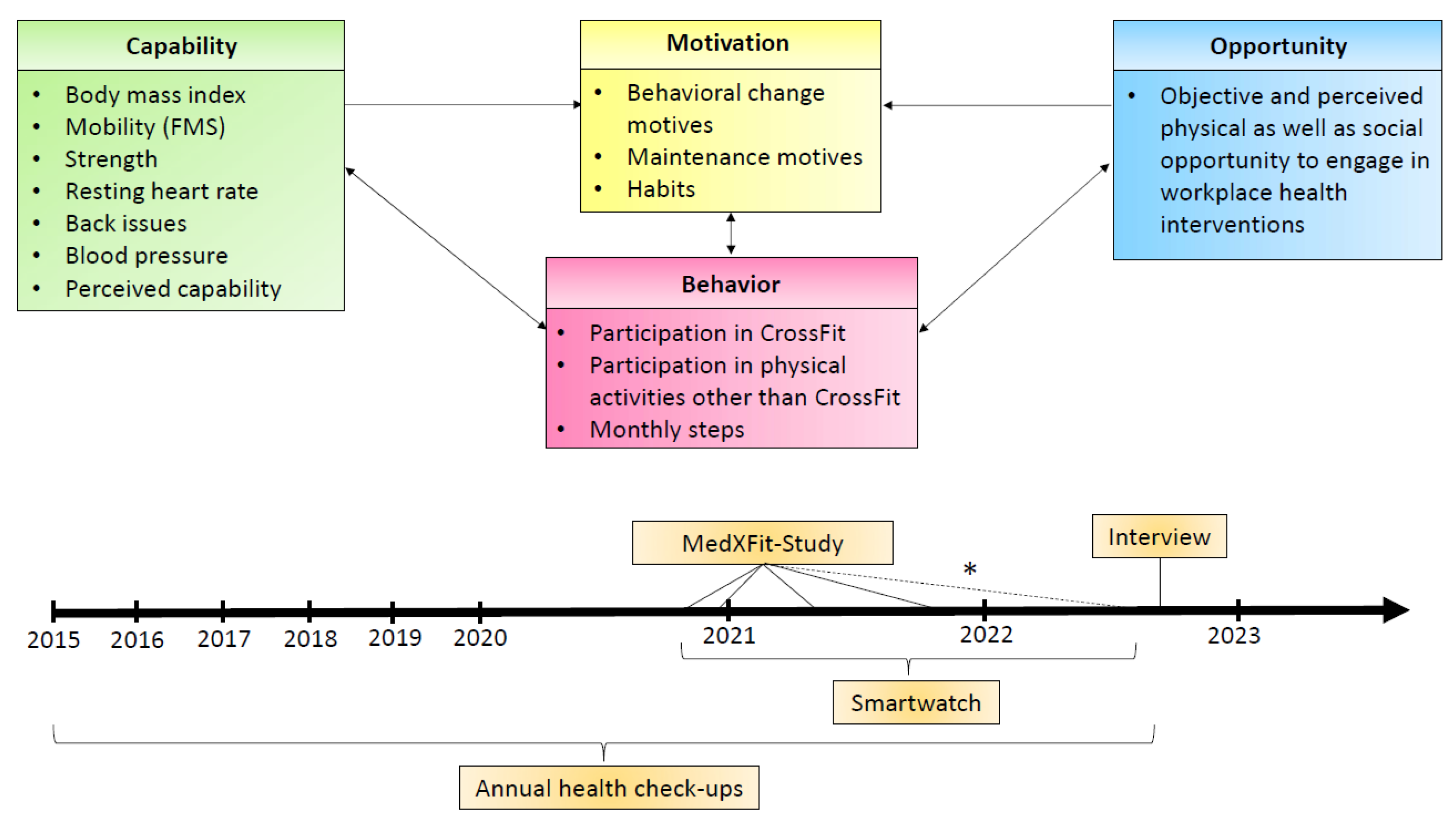
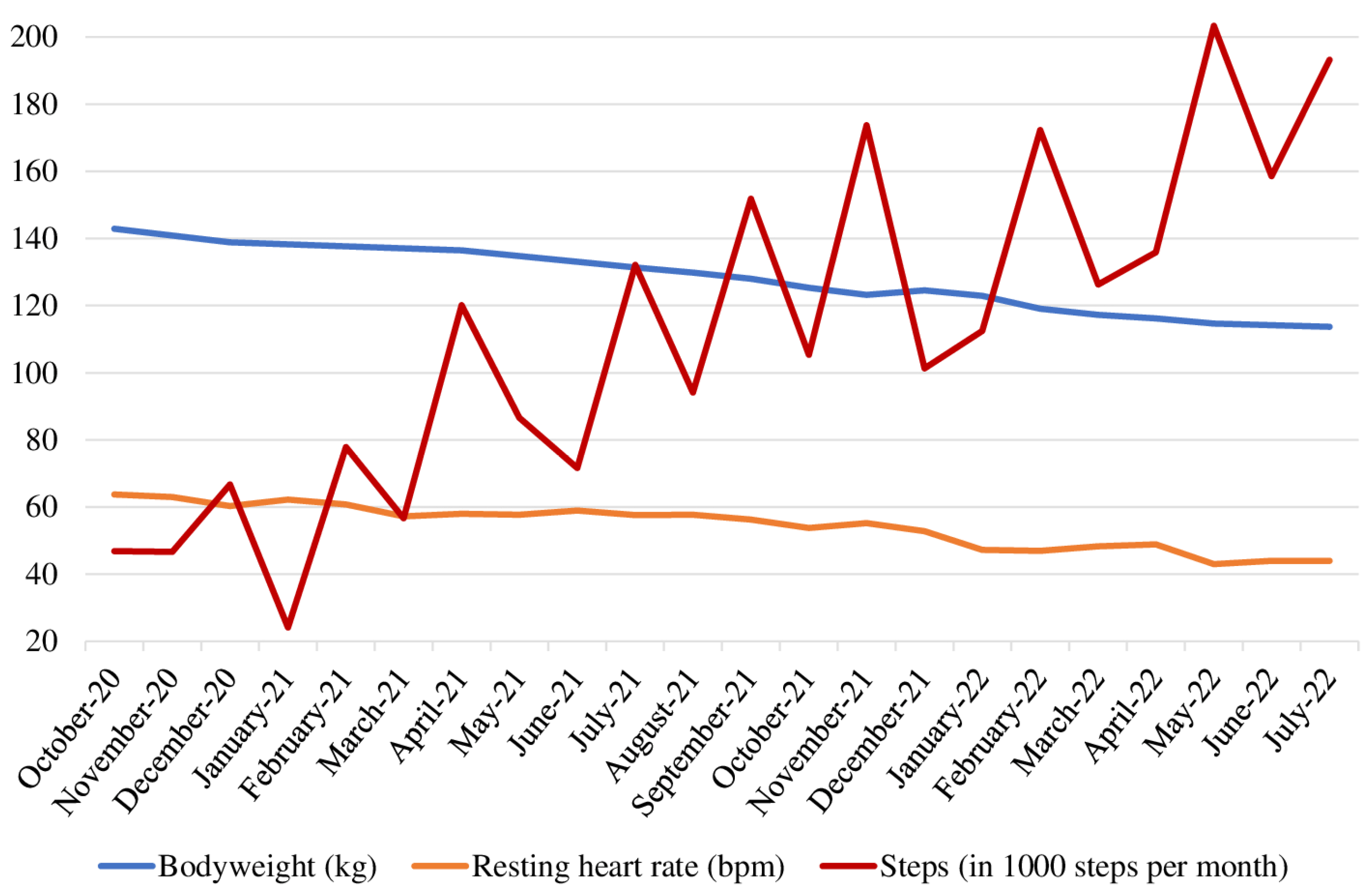
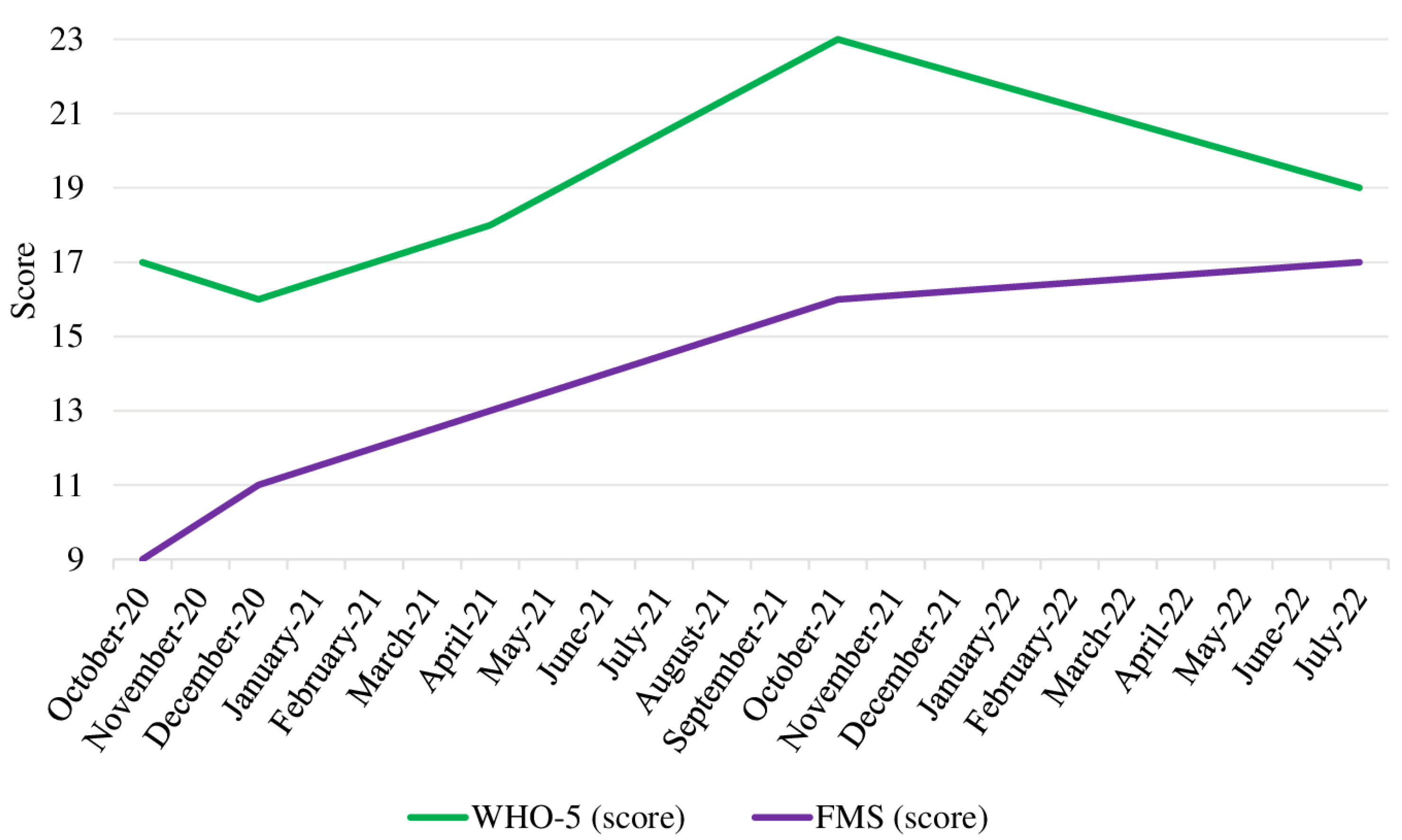
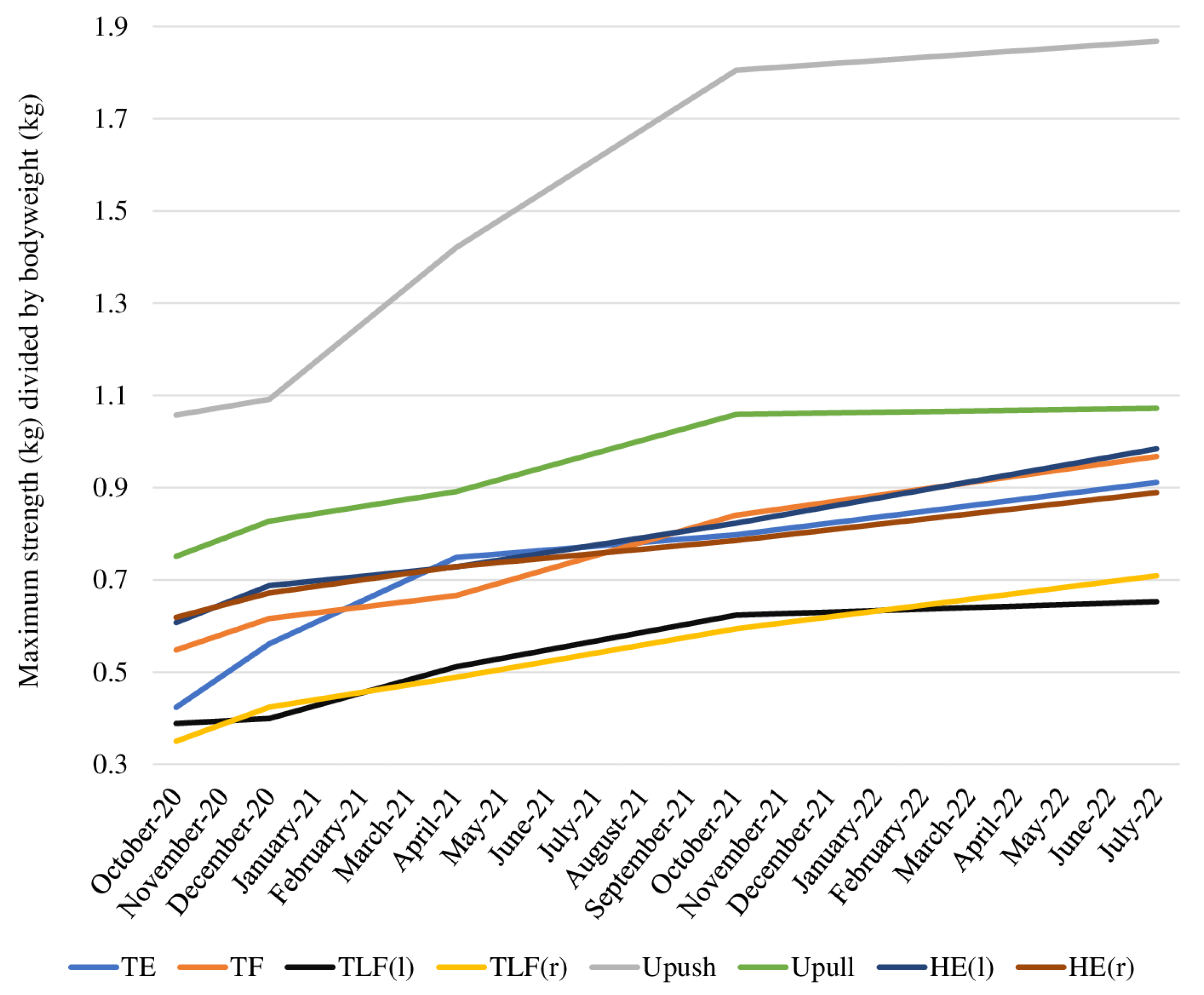
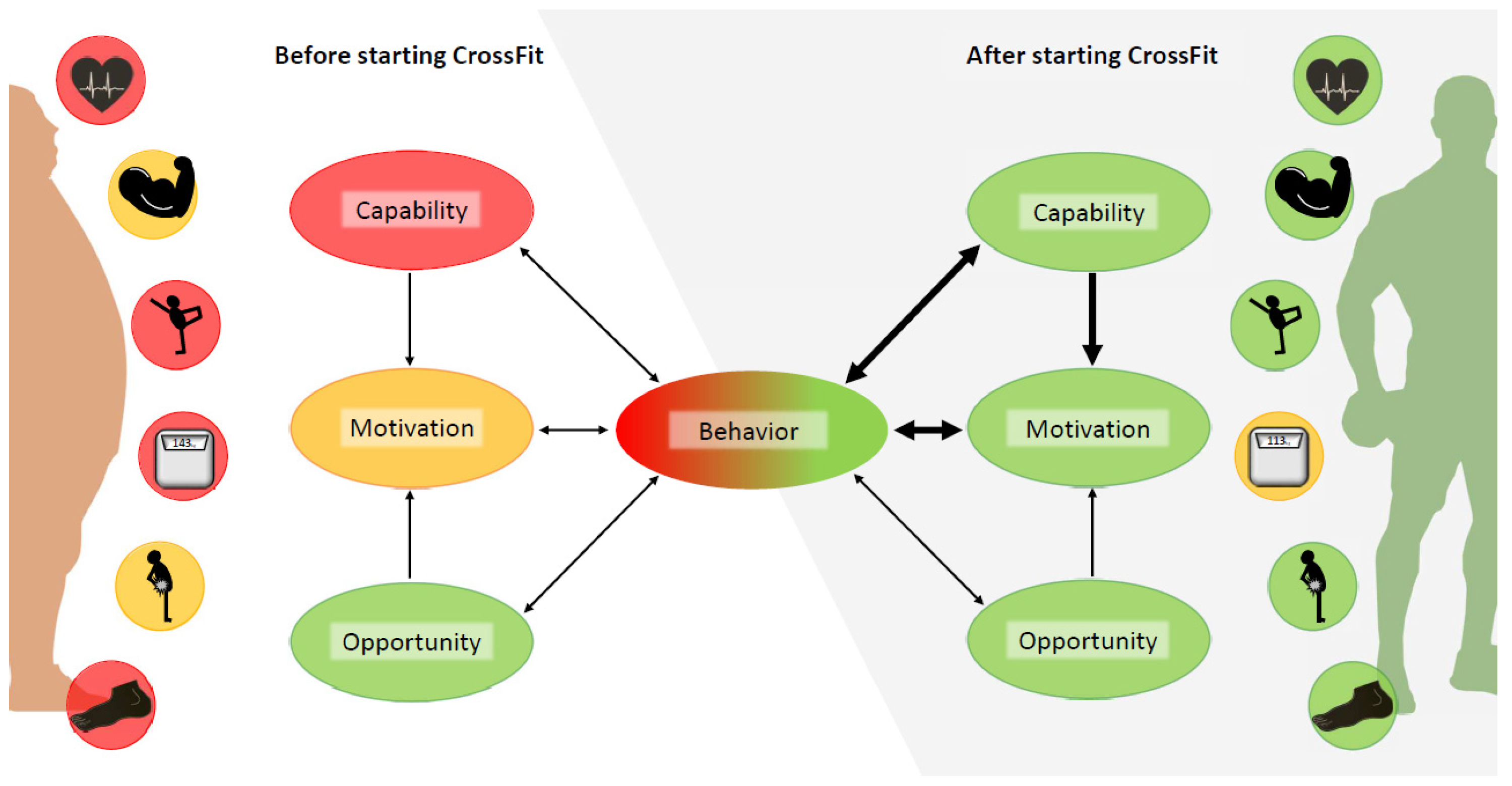
| Variable | October 2020 | December 2020 | April 2021 | August 2021 | October 2021 | June 2022 | July 2022 |
|---|---|---|---|---|---|---|---|
| Bodyweight (kg) | 142.9 | 138.9 | 136.5 | 129.8 | 125.3 | 114.2 | 113.7 |
| BMI in kg/m2 | 41.3 | 40.2 | 39.5 | 37.5 | 36.2 | 33 | 32.9 |
| Resting heart rate (bpm) | 64 | 60 | 58 | 57 | 54 | 44 | 44 |
| Steps/month | 46,887 | 66,762 | 120,118 | 94,149 | 105,392 | 158,546 | 193,230 |
| Well-being (WHO-5 score) | 17 | 16 | 18 | 23 | 19 | ||
| FMS (score) | 9 | 11 | 13 | 16 | 17 | ||
| TE (kg) | 60.5 | 78 | 102 | 100 | 103.6 | ||
| TF (kg) | 78.3 | 85 | 90 | 105.3 | 110 | ||
| TLF(l) (kg) | 55.5 | 55 | 69 | 78.1 | 74.2 | ||
| TLF(r) (kg) | 50 | 58 | 66 | 74.4 | 80.6 | ||
| UPush (kg) | 151.1 | 151 | 193 | 226.2 | 212.4 | ||
| UPull (kg) | 107.3 | 114 | 121 | 132.7 | 121.9 | ||
| HE(l) (kg) | 86.8 | 95 | 99 | 103.1 | 111.9 | ||
| HE(r) (kg) | 88.4 | 93 | 99 | 98.4 | 101.1 | ||
| LBI intensity (score) | 3 | 2 | 0 | 0 | 0 | ||
| LBI limitation (score) | 3 | 3 | 0 | 0 | 0 | ||
| LBI frequency days/week | 1 | 3 | 0 | 0 | 0 |
Disclaimer/Publisher’s Note: The statements, opinions and data contained in all publications are solely those of the individual author(s) and contributor(s) and not of MDPI and/or the editor(s). MDPI and/or the editor(s) disclaim responsibility for any injury to people or property resulting from any ideas, methods, instructions or products referred to in the content. |
© 2023 by the authors. Licensee MDPI, Basel, Switzerland. This article is an open access article distributed under the terms and conditions of the Creative Commons Attribution (CC BY) license (https://creativecommons.org/licenses/by/4.0/).
Share and Cite
Brandt, T.; Schinköthe, T.; Schmidt, A. CrossFit Motivates a 41-Year-Old Obese Man to Change His Lifestyle and Achieve Long-Term Health Improvements: A Case Report. J. Funct. Morphol. Kinesiol. 2023, 8, 58. https://doi.org/10.3390/jfmk8020058
Brandt T, Schinköthe T, Schmidt A. CrossFit Motivates a 41-Year-Old Obese Man to Change His Lifestyle and Achieve Long-Term Health Improvements: A Case Report. Journal of Functional Morphology and Kinesiology. 2023; 8(2):58. https://doi.org/10.3390/jfmk8020058
Chicago/Turabian StyleBrandt, Tom, Timo Schinköthe, and Annette Schmidt. 2023. "CrossFit Motivates a 41-Year-Old Obese Man to Change His Lifestyle and Achieve Long-Term Health Improvements: A Case Report" Journal of Functional Morphology and Kinesiology 8, no. 2: 58. https://doi.org/10.3390/jfmk8020058
APA StyleBrandt, T., Schinköthe, T., & Schmidt, A. (2023). CrossFit Motivates a 41-Year-Old Obese Man to Change His Lifestyle and Achieve Long-Term Health Improvements: A Case Report. Journal of Functional Morphology and Kinesiology, 8(2), 58. https://doi.org/10.3390/jfmk8020058







